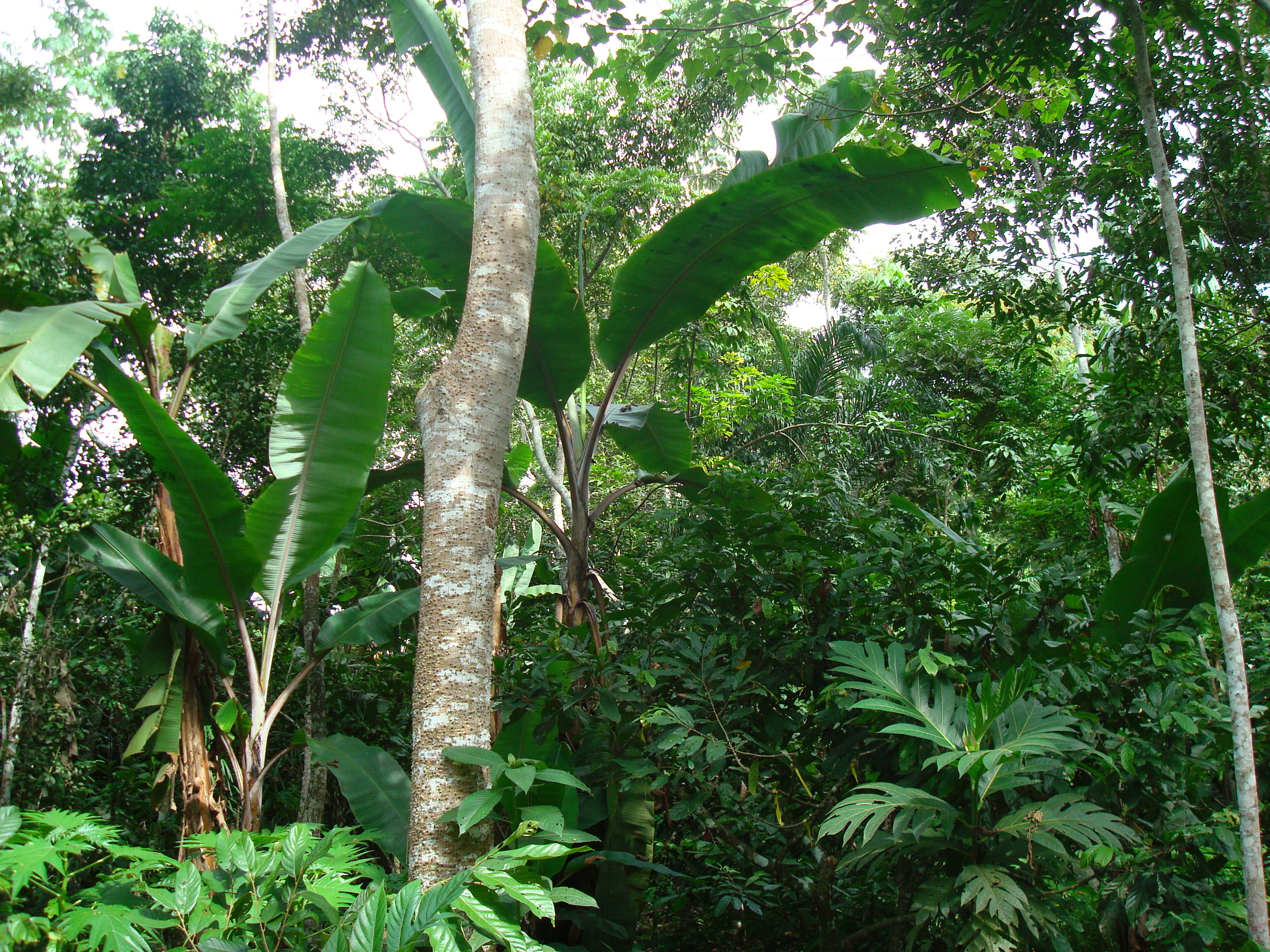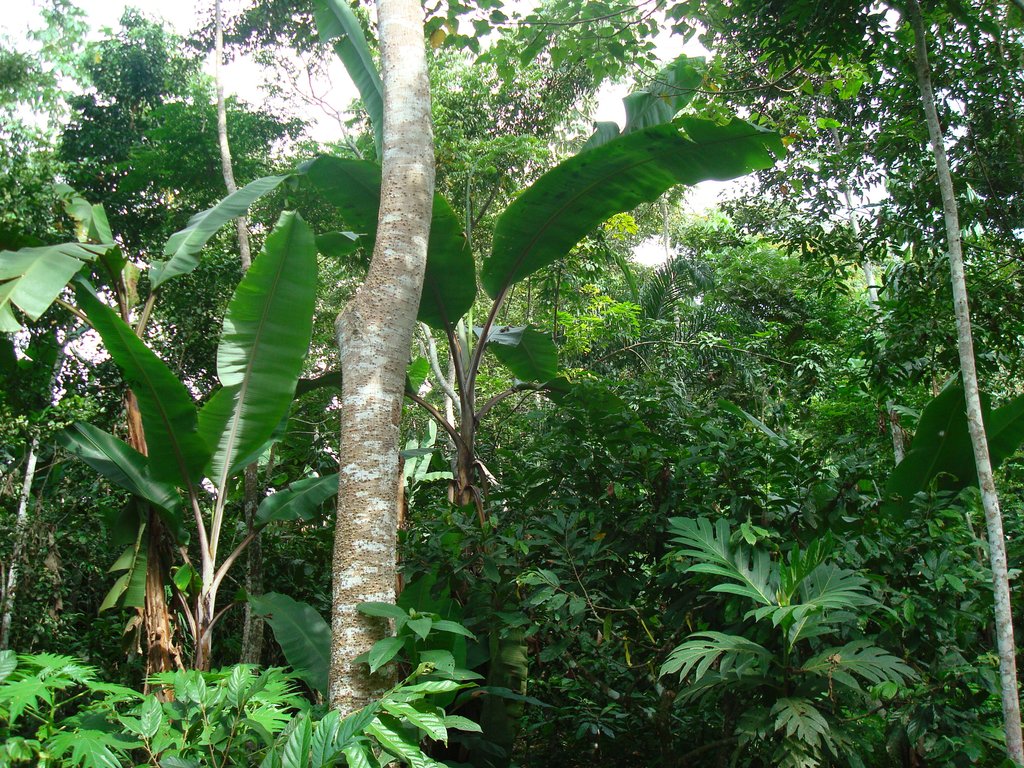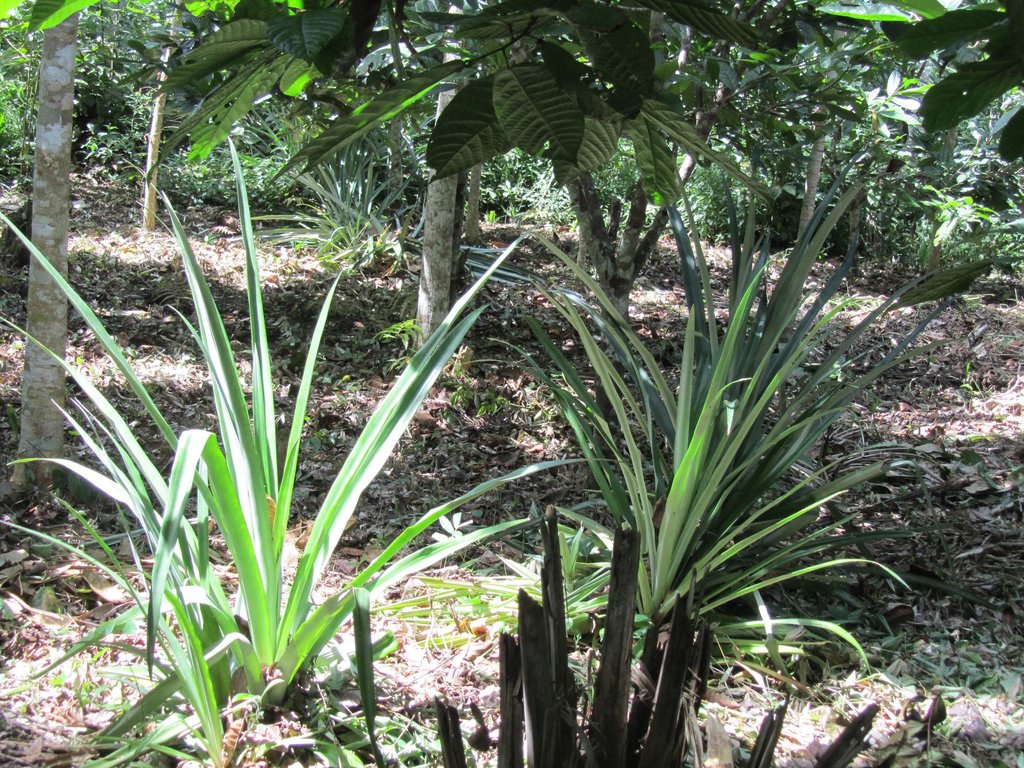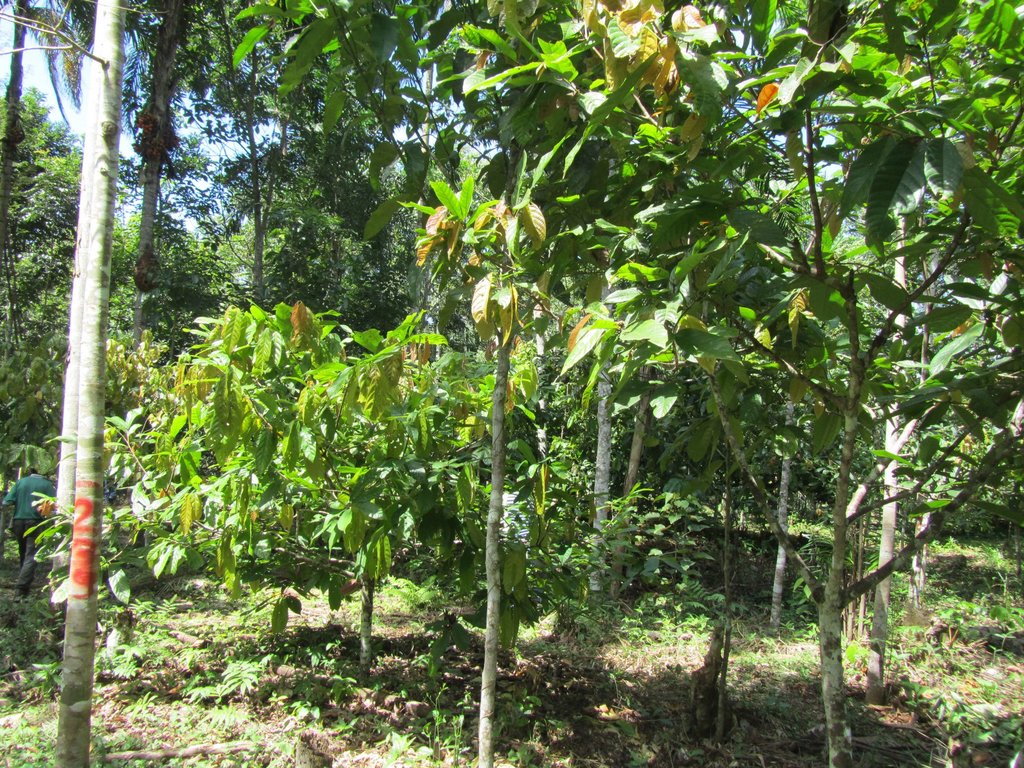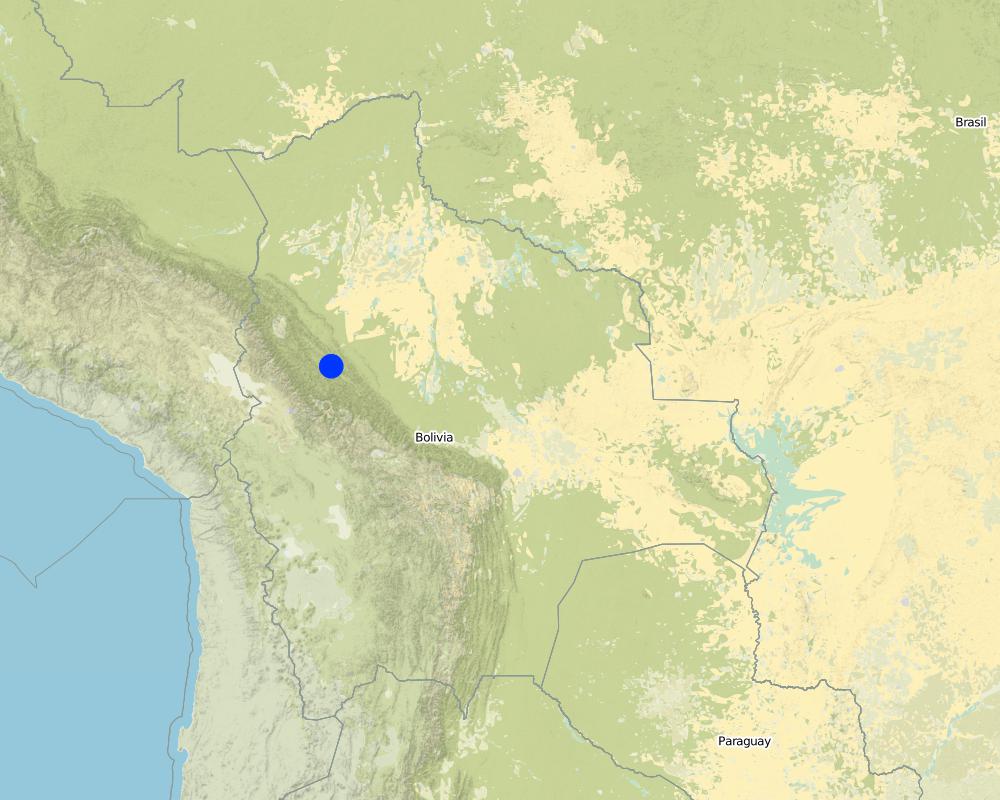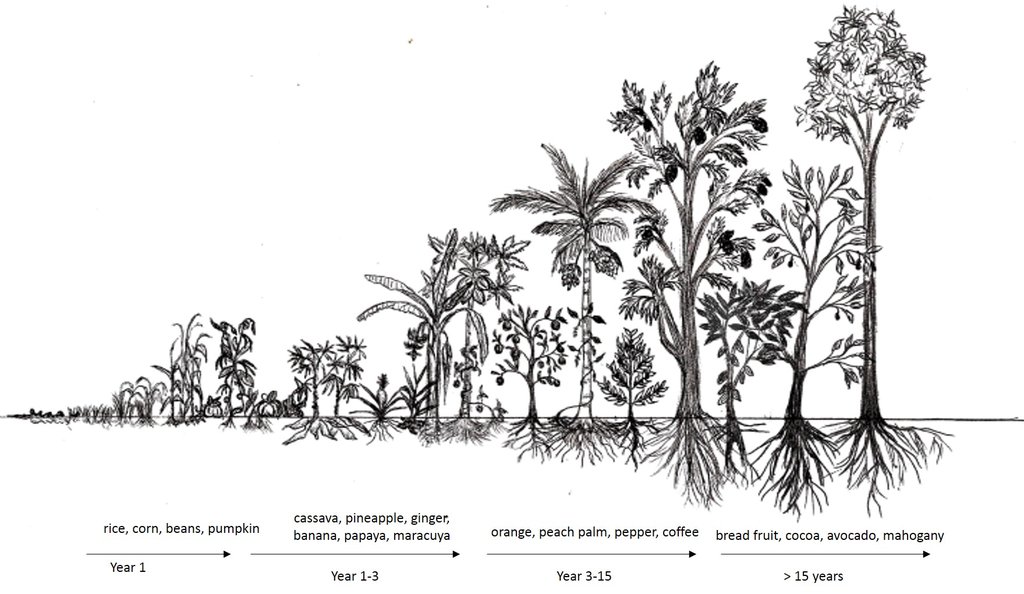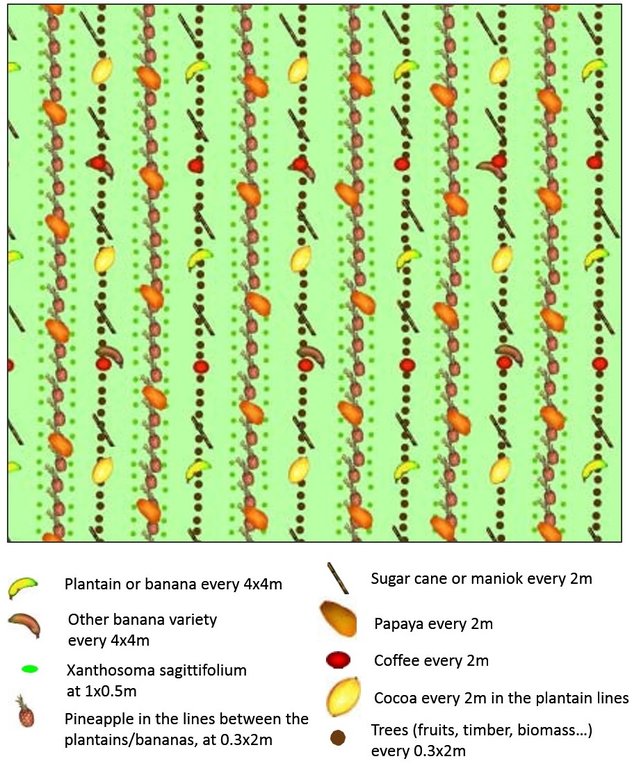Dynamic agroforestry systems [玻利维亚,多民族国家]
- 创建:
- 更新:
- 编制者: Johanna Jacobi
- 编辑者: –
- 审查者: Alexandra Gavilano
Sistemas agroforestales dinámicos o sucesionales (Safs)
technologies_513 - 玻利维亚,多民族国家
查看章节
全部展开 全部收起1. 一般信息
1.2 参与该技术评估和文件编制的资源人员和机构的联系方式
1.3 关于使用通过WOCAT记录的数据的条件
编制者和关键资源人员接受有关使用通过WOCAT记录数据的条件。:
是
1.4 所述技术的可持续性声明
这里所描述的技术在土地退化方面是否存在问题,导致无法被认为是一种可持续的土地管理技术?:
否
2. SLM技术的说明
2.1 技术简介
技术定义:
Dynamic agroforestry systems are highly diversified farming systems which go through the different phases of the natural succession, from pioneer plant dominated stages up to primary trees dominated stages, were the different strata are used for different crops, and where pruning and selective weeding enhances the dynamic development of plant synergies.
2.2 技术的详细说明
说明:
The approach is different from simple agroforestry because it makes use of the different strata and stages of natural succession which it mimicks with crops and native plants that accumulate biomass and create shade and enabling conditions while crops are small. Main activities are pruning and selective weeding. Managing such a system requires a profound knowledge of locally adapted crops and the local vegeation, and also of plant growth dynamics. There is no general recipe as a dynamic agroforestry system looks different in each place, but there are universal agroecological principles such as the natural succession stages and biodiversity. Dynamic agroforestry is like other agroforestry systems useful to implement an efficient land-use system which does not necessarily degrade soils, water sources and biodiversity, while producing different goods (food, feed, construction material, medicines....) at different times of the year. Dynamic agroforestry have the specialty that the pioneer plants produce already in the first year (e.g. rice or corn), so that a hunger gap can be avoided until the main crop (e.g. cocoa) starts producing after several years. There is a long history of capacity building, field trials and farmers own experiments in different ecoregions of Bolivia. Farmer-to-farmer trainings have been used as well as NGO-led projects to install plots on farmers' lands. In Bolivia, different groups of farmers and NGOs started to use dynamic agroforestry after courses by Ernst Götsch from Brazil in Alto Beni in Bolivia with cocoa agroforestry systems in the 1990s. From there the knowledge spread constantly through different people experimenting, mainla in the sub-humid lowlands of the Amazon Basin, but also in semi-arid regions around Cochabamba. Today there are many exchanging events with interested farmers and experts fom other countries, and a larger dynamic agroforestry project in Cote D'Ivoire. There is also an annual international one-week course on dynamic agroforestry taking place in Bolivia led by the NGO Ecotop. NGO founders from different parts of the world who have long been living in Bolivia and manage agroforestry farms themselves have been playing an important role in advancing the approach by organizing courses and events, some scientists have conducted research on soil fertility, yields, pests and diseases, and many farmers have long-standing experience from experiments with dynamic agroforestry on their land.
2.3 技术照片
2.5 已应用该技术的、本评估所涵盖的国家/地区/地点
国家:
玻利维亚,多民族国家
区域/州/省:
Alto Beni/La Paz
具体说明该技术的分布:
- 适用于特定场所/集中在较小区域
注释:
Implemented by "lighthouse" farmers, and participants of projects
Map
×2.6 实施日期
如果不知道确切的年份,请说明大概的日期:
- 10-50年前
2.7 技术介绍
详细说明该技术是如何引入的:
- 在实验/研究期间
- 通过项目/外部干预
注释(项目类型等):
Exchange with agroforestry farmers from other places (e.g. Ernst Götsch, Bahia Brazil)
3. SLM技术的分类
3.1 该技术的主要目的
- 改良生产
- 减少、预防、恢复土地退化
- 保护生态系统
- 结合其他技术保护流域/下游区域
- 保持/提高生物多样性
- 适应气候变化/极端天气及其影响
- 减缓气候变化及其影响
3.2 应用该技术的当前土地利用类型

农田
- 一年一作
- 多年一作(非木材)
- 乔木与灌木的种植
- rice, corn
乔木和灌木种植 - 指定作物:
- 可可
- 柑橘属
- 木瓜
- banana
每年的生长季节数:
- 1
具体说明:
Annual crops are grown in the rainy season

森林/林地
产品和服务:
- 木材
- 薪材
- 水果和坚果
- 其它森林产品
- 自然灾害防护
3.4 供水
该技术所应用土地的供水:
- 雨养
注释:
Great vulnerbaility of cash and food crops to drought (e.g. cocoa trees)
3.5 该技术所属的SLM组
- 农业林学
3.6 包含该技术的可持续土地管理措施

植物措施
- V1:乔木和灌木覆盖层

管理措施
- M1:改变土地使用类型
- M2:改变管理/强度级别
- M3:根据自然和人文环境进行布局
- M4:活动时间安排的重大变化
- M5:物种组成的控制/变化
3.7 该技术强调的主要土地退化类型

土壤水蚀
- Wt:表土流失/地表侵蚀
- Wm:块体运动/滑坡

土壤风蚀
- Et:表土流失

化学性土壤退化
- Cn:肥力下降和有机质含量下降(非侵蚀所致)
- Ca:酸化

物理性土壤退化
- Pc:压实

生物性退化
- Bc:植被覆盖的减少
- Bh:栖息地丧失
- Bq:数量/生物量减少
- Bf:火灾的有害影响
- Bs:质量和物种组成/多样性的下降
- Bl:土壤寿命损失
- Bp:害虫/疾病增加,捕食者减少

水质恶化
- Ha:干旱化
- Hs:地表水良变化
3.8 防止、减少或恢复土地退化
具体数量名该技术与土地退化有关的目标:
- 防止土地退化
- 修复/恢复严重退化的土地
4. 技术规范、实施活动、投入和成本
4.1 该技术的技术图纸
技术规范(与技术图纸相关):
For reasons of visibility, the vertical drawing only contains crops and not plants that are planted in between for biomass accumulation . The recommendations to install the plot are as follows:
plantain or banana every 4 m; another banana variety (mainly red banana) every 4m in alternating rows so that banana/plantain rows result with 2m distance; Pineapple between the banana and plantain rows every 0.3 m with 2m distance between the rows; hualuza (Xanthosoma sagittifolium) every 0.5m left and right to the rows with pineapple; sugar cane or maniok every 2m in the plantain/banan rows; papaya every 2m in the plantain/banana rows; fruit trees, timber trees and biomass-accumulating trees every 0.3m in the banana/plantain rows with a distance of 2m between rows; café every 2m in the banana/plantain rows; cocoa every 4m in the banana/plantain rows. Rice, Cajanus cajan, corn and hibiscus should be sown everywhere in between.
作者:
Yana and Weinert 2001, altered
日期:
2001
4.2 有关投入和成本计算的一般信息
具体说明成本和投入是如何计算的:
- 每个技术区域
注明尺寸和面积单位:
1 hectare
其它/国家货币(具体说明):
BOB
注明雇用劳工的每日平均工资成本:
100 BOB
4.3 技术建立活动
| 活动 | 时间(季度) | |
|---|---|---|
| 1. | Plot establishment withour burning | When the rains start |
| 2. | selective weeding | Every 3 months |
| 3. | Pruning | Before the rains start |
| 4. | Harvesting | Constant |
4.4 技术建立所需要的费用和投入
注释:
Implementing a dynamic agorofrestry plot with cocoa costs 3500-3600 BOB/ha, as compared to a cocoa monoculture with around 1400 BOB/ha. However, this expenditure is recovered during the first year through annual crops such as rice, causing a net gain in dynamic agroforestry plots of around 3000 BOB/ha whereas cocoa monocultures have a let loss of around 300 BOB in the first year (since there are no annual crops to sell).
4.5 维护/经常性活动
| 活动 | 时间/频率 | |
|---|---|---|
| 1. | Selective weeding | Every three months |
| 2. | Pruning | Before rains start |
| 3. | Harvesting | Continuous |
| 4. | Replanting | During rainy season |
4.6 维护/经常性活动所需要的费用和投入(每年)
如果您无法分解上表中的成本,请估算维护该技术所需要的总成本。:
1000.0
4.7 影响成本的最重要因素
描述影响成本的最决定性因素:
Available labor
5. 自然和人文环境
5.1 气候
年降雨量
- < 250毫米
- 251-500毫米
- 501-750毫米
- 751-1,000毫米
- 1,001-1,500毫米
- 1,501-2,000毫米
- 2,001-3,000毫米
- 3,001-4,000毫米
- > 4,000毫米
指定年平均降雨量(若已知),单位为mm:
1500.00
有关降雨的规范/注释:
Mainly in rainy season from November to March
注明所考虑的参考气象站名称:
Estación experimental El Ceibo Sapecho
农业气候带
- 半湿润
5.2 地形
平均坡度:
- 水平(0-2%)
- 缓降(3-5%)
- 平缓(6-10%)
- 滚坡(11-15%)
- 崎岖(16-30%)
- 陡峭(31-60%)
- 非常陡峭(>60%)
地形:
- 高原/平原
- 山脊
- 山坡
- 山地斜坡
- 麓坡
- 谷底
垂直分布带:
- 0-100 m a.s.l.
- 101-500 m a.s.l.
- 501-1,000 m a.s.l.
- 1,001-1,500 m a.s.l.
- 1,501-2,000 m a.s.l.
- 2,001-2,500 m a.s.l.
- 2,501-3,000 m a.s.l.
- 3,001-4,000 m a.s.l.
- > 4,000 m a.s.l.
说明该技术是否专门应用于:
- 凸形情况
5.3 土壤
平均土层深度:
- 非常浅(0-20厘米)
- 浅(21-50厘米)
- 中等深度(51-80厘米)
- 深(81-120厘米)
- 非常深(> 120厘米)
土壤质地(表土):
- 粗粒/轻(砂质)
- 中粒(壤土、粉土)
土壤质地(地表以下> 20厘米):
- 粗粒/轻(砂质)
表土有机质:
- 中(1-3%)
如有可能,附上完整的土壤描述或具体说明可用的信息,例如土壤类型、土壤酸碱度、阳离子交换能力、氮、盐度等。:
Ph: 6-7.8, P: 15-17.8 mg/kg, N: 0.12-0.18%, SOM: 1.2-1.8%, K: 0.12-0.8 cmolc/kg, CEC: 8.2-15.4 cmolc/kg (all 0-25 cm depth)
5.4 水资源可用性和质量
地下水位表:
< 5米
地表水的可用性:
好
水质(未处理):
良好饮用水
水的盐度有问题吗?:
否
该区域正在发生洪水吗?:
是
规律性:
偶然
5.5 生物多样性
物种多样性:
- 高
栖息地多样性:
- 高
关于生物多样性的注释和进一步规范:
The Tropical Andes which the Yungas of La Paz form part of, are a "hot spot of biodiversity"
5.6 应用该技术的土地使用者的特征
定栖或游牧:
- 定栖的
生产系统的市场定位:
- 混合(生计/商业)
非农收入:
- 收入的10-50%
相对财富水平:
- 平均水平
个人或集体:
- 个人/家庭
机械化水平:
- 手工作业
性别:
- 女人
- 男人
土地使用者的年龄:
- 青年人
- 中年人
5.7 应用该技术的土地使用者使用的平均土地面积
- < 0.5 公顷
- 0.5-1 公顷
- 1-2 公顷
- 2-5公顷
- 5-15公顷
- 15-50公顷
- 50-100公顷
- 100-500公顷
- 500-1,000公顷
- 1,000-10,000公顷
- > 10,000公顷
这被认为是小规模、中规模还是大规模的(参照当地实际情况)?:
- 小规模的
注释:
Frequently, only 1-5 ha of the 12-15 ha that every family has is used for cropping
5.8 土地所有权、土地使用权和水使用权
土地所有权:
- 个人,有命名
土地使用权:
- 个人
用水权:
- 社区(有组织)
5.9 进入服务和基础设施的通道
健康:
- 贫瘠
- 适度的
- 好
教育:
- 贫瘠
- 适度的
- 好
技术援助:
- 贫瘠
- 适度的
- 好
就业(例如非农):
- 贫瘠
- 适度的
- 好
市场:
- 贫瘠
- 适度的
- 好
能源:
- 贫瘠
- 适度的
- 好
道路和交通:
- 贫瘠
- 适度的
- 好
饮用水和卫生设施:
- 贫瘠
- 适度的
- 好
金融服务:
- 贫瘠
- 适度的
- 好
6. 影响和结论性说明
6.1 该技术的现场影响
社会经济效应
生产
作物生产
SLM之前的数量:
350 kg/ha/y dry cocoa beans
SLM之后的数量:
510 kg/ha/y dry cocoa beans
注释/具体说明:
The implementation of the tecnology implied a better understanding of cocoa growing in general (e.g. in terms of pruning) which may have led to the higher yields under dynamic agroforestry
木材生产
SLM之前的数量:
0
SLM之后的数量:
abundant
注释/具体说明:
A mahogany tree can be grown every 12m in a dynamic agroforestry cocoa plot, but its development depends on many differnt factors.
非木材林业生产
注释/具体说明:
The highly diversified plota provide many different NTFP
生产故障风险
注释/具体说明:
Vulnerability to food insecurity decreased greatly, economic risk decreases moderately as cocoa is still the most important cash crop and crop failure can also occur in dynamic agroforestry plots.
产品多样性
SLM之前的数量:
1-3
SLM之后的数量:
10-15
收入和成本
农业收入
SLM之前的数量:
6044 BOB/y/family
SLM之后的数量:
7530 BOB/y/family
注释/具体说明:
Connected to organic and Fair Trade certificacion which the monoculture farmers usually don't have
收入来源的多样性
SLM之前的数量:
3.5
SLM之后的数量:
3.2
注释/具体说明:
People invested more in cocoa farming than in off-farm income sources
工作量
注释/具体说明:
2410 SAF vs 5000 Mono costo mano de obra
6.2 该技术的场外影响已经显现
对场外影响(测量)的评估进行具体说明:
no specific
6.3 技术对渐变气候以及与气候相关的极端情况/灾害的暴露和敏感性(土地使用者认为的极端情况/灾害)
气候有关的极端情况(灾害)
气候灾害
| 该技术是如何应对的? | |
|---|---|
| 热浪 | 非常好 |
| 干旱 | 适度 |
生物灾害
| 该技术是如何应对的? | |
|---|---|
| 流行病 | 适度 |
注释:
A main benefit related to climate change aspects according to the land users is that they can work in the shade.
6.4 成本效益分析
技术收益与技术建立成本相比如何(从土地使用者的角度看)?
短期回报:
轻度消极
长期回报:
积极
技术收益与技术维护成本/经常性成本相比如何(从土地使用者的角度看)?
短期回报:
非常积极
长期回报:
稍微积极
6.5 技术采用
- 1-10%
在所有采用这项技术的人当中,有多少人是自发的,即未获得任何物质奖励/付款?:
- 51-90%
注释:
Most have participated in a course and/or received some technical advice, but mostly without material incentives
6.6 适应
最近是否对该技术进行了修改以适应不断变化的条件?:
是
其它(具体说明):
Lack of in-depth knowledge
具体说明技术的适应性(设计、材料/品种等):
Simplified versions have been tried out (with less density and iversity of plants)
6.7 该技术的优点/长处/机会
| 土地使用者眼中的长处/优势/机会 |
|---|
| Ecologically adapted, favorable working conditions (shade, cooler than full-sun systems), diversity of products |
| 编制者或其他关键资源人员认为的长处/优势/机会 |
|---|
| Short-term (annual crops first year). mid-term (cocoa etc.) and long-term economic strategy when high-value timber trees are included (e.g. mahogany) |
6.8 技术的弱点/缺点/风险及其克服方法
| 土地使用者认为的弱点/缺点/风险 | 如何克服它们? |
|---|---|
| Sometimes, yields are low. Produce cannot always be sold at a good price | Technical support, develop market access |
| 编制者或其他关键资源人员认为的弱点/缺点/风险 | 如何克服它们? |
|---|---|
| If not well managed, returns are very low | Invest in good management practices, capacity building, develop markets for high-qualtiy products |
7. 参考和链接
7.1 信息的方法/来源
- 实地考察、实地调查
15
- 与土地使用者的访谈
52
- 与SLM专业人员/专家的访谈
2
- 根据报告和其他现有文档进行编译
(现场)数据是什么时候汇编的?:
2011
7.2 参考可用出版物
标题、作者、年份、ISBN:
Milz, J. (1997) Guía para el establecimiento de Sistemas Agroforestales. DED La Paz.
标题、作者、年份、ISBN:
Yana W, Weinert H (2001) Ténicas de sistemas agroforestales multiestrato—manual prático. PIAF-El Ceibo, La Paz
标题、作者、年份、ISBN:
Schnatmann, A. (2006) Análisis Ecnómico de Rentabilidad - Parcelas Agroforestales Multiestrado. Interinstitucional Alto Beni
7.3 链接到网络上的相关信息
标题/说明:
Plaform of agroforestry activities
URL:
http://ecosaf.org/
标题/说明:
NGO working in the field of successional/dynamic agroforestry
URL:
http://www.ecotop-consult.de/approach_and_solutions/15/
链接和模块
全部展开 全部收起链接
无链接
模块
无模块


